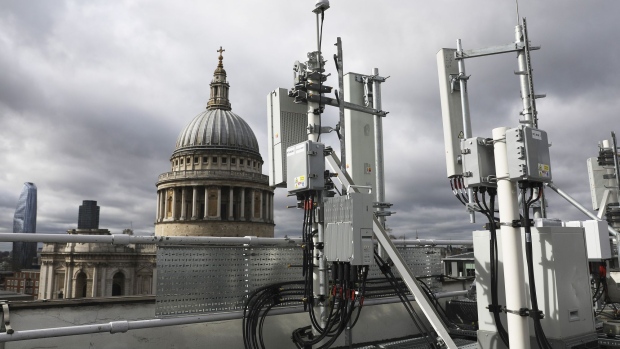Jul 15, 2020
U.K. Phone Market Will Be Duopoly for Years After Huawei Ban
, Bloomberg News

(Bloomberg) -- With Huawei Technologies Co. barred from Britain’s future wireless networks, its two European rivals look set to split the market.
The ban -- forcing phone companies to remove 5G Huawei equipment by 2027 and stop buying it by the end of this year -- is a blow to the industry, which had lobbied hard to keep Huawei, and not just because of the burden of having to redesign the next-generation networks they were already building.
Read more: U.K. Bans Huawei From 5G Networks in Security Crackdown
It also turns Britain’s wireless radio equipment market into an effective duopoly of Finland’s Nokia Oyj and Ericsson AB of Sweden. The companies that run Britain’s communications infrastructure will be bracing for higher prices and will have little choice but to use both Nokia and Ericsson if they are to avoid becoming dangerously reliant on either vendor.
“In the short term, carriers can play one supplier off against the other,” said James Barford, an analyst at Enders Analysis. “But a medium- to long-term consequence of not having Huawei means less pricing tension in the market.”
Huawei was popular with carriers because of its competitive pricing, and its emphasis on research and development, which often gave its gear a technological edge.
Carriers tend to get the best equipment deals in the early stages of a network rollout because suppliers are willing to sacrifice profits to win a decent slice of the market. Removing Huawei from the mix so early in the cycle for the 5G upgrade means the phone companies miss an opportunity for steeper discounts.
The two European suppliers have a further opportunity to entrench their position against newcomers as carriers will need to swap out some of their Huawei 4G gear for Nokia and Ericsson equipment before installing 5G.
Act Now
Tuesday’s decision was especially welcome for Nokia, which has struggled to gain traction in 5G equipment. Cormac Whelan, chief executive officer for Nokia in the U.K. and Ireland, said “we have the capacity and expertise to replace all of the Huawei equipment in the U.K.’s networks at scale and speed.”
Ericsson Vice President Arun Bansal said carriers can prevent increased costs and substantial delays by swapping out Huawei equipment sooner.
“The whole mobile infrastructure is built with swaps every five to seven years, depending on the technology cycle,” he said. “The longer it takes to swap, the more cost operators have.”
When the U.K. government began planning Huawei restrictions earlier this year, it opened talks with Japan’s NEC Corp. and Samsung Electronics Co. to determine whether those companies could replace Huawei, a person familiar with the matter said at the time. But there’s been no word of progress on those talks since early June when they were reported by Bloomberg.
Read more: U.K. Opens Talks With Huawei Rival as Johnson Confronts China
“As a global provider of 5G network solutions, we would welcome the opportunity to support the U.K.’s 5G network roll-out,” Samsung said in an emailed statement.
A representative for NEC didn’t immediately respond to a request for comment at its European offices.
Even if a company like Samsung was able to step into Huawei’s place for 5G, it would have to make technology that works with the older 2G and 3G standards that still exist in U.K. networks. European operators like to use compatible gear for all of the generations of wireless service, which makes it easier to allocate signal across the technologies and use their spectrum more efficiently, Enders’s Barford said.
Open Architecture
Carriers are also trying to help themselves by lobbying for a more open network architecture that would make it easier to plug in parts from different suppliers.
Read more: Huawei Scare Pushes Carriers to Tackle Dominance of 5G Suppliers
Vodafone has begun issuing small contracts for OpenRAN, an initiative that aims to standardize radio access network hardware and software. CEO Nick Read said last October that Vodafone was “ready to fast track it into Europe as we seek to actively expand our vendor ecosystem.”
However keen carriers are to introduce an open standard, availability may be limited for years to come.
“Within the time of the Huawei switch out, there will be some OpenRAN options,” said Robert Grindle, an analyst at Deutsche Bank AG. “I wouldn’t be surprised if there were OpenRAN adoptions within the six-and-a-half year time frame.”
©2020 Bloomberg L.P.





